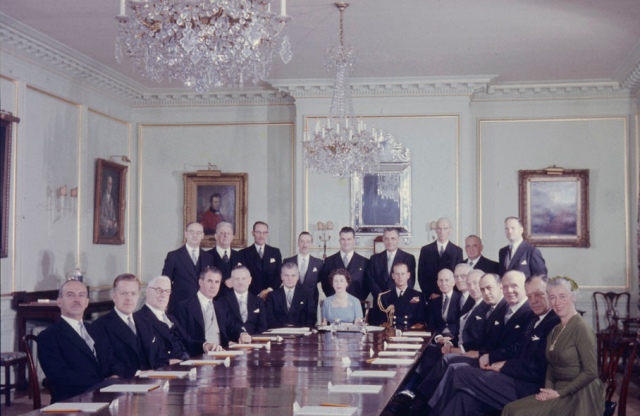 Queen Elizabeth and Prince Philip at the head table with Prime Minister John Diefenbaker, the Governor General Vincent Massey and other politicians and officials ,1957 [photo: Library and Archives Canada]
Queen Elizabeth and Prince Philip at the head table with Prime Minister John Diefenbaker, the Governor General Vincent Massey and other politicians and officials ,1957 [photo: Library and Archives Canada]
[These are two excerpts from an article which appears in the latest issue of The Round Table: The Commonwealth Journal of International Affairs.]
Hurdles
The decision by the United Kingdom to enter into the EEC faced several hurdles as the governments of Harold Macmillan and later Edward Heath attempted to navigate the varying demands of both the Commonwealth’s trade expectations and the EEC’s accession requirements with the eventual goal of appeasing both sides. Prior to the first application for entry into the EEC, the British government was acutely aware that the Commonwealth would potentially take a contrary position and cabinet internal memoranda sought to develop a communications strategy in order to assuage the concerns of the Commonwealth. One month prior to Great Britain’s application to join the EEC in July 1961, the prime minister issued a cabinet memo stressing ‘Commonwealth Ministers may in general accept the political case for our joining of the Six, although Canada will have reservations and Australia (or at least the Prime Minister, Mr. Menzies) may see possible countervailing damage to the political cohesion of the Commonwealth’. The cabinet well understood prior concerns made by the senior Dominions of the Commonwealth, and their fears of Canada becoming uncooperative or hostile to a Great Britain inside the EEC were widely shared by senior officials in London. Britain understood that it was far stronger dealing with the Dominions individually rather than grouped at a meeting of the Commonwealth and so Macmillan dispatched his ministers to negotiate with the senior members of the Commonwealth one-on-one. One of their priorities was to make it clear to Canada and the others that the United Kingdom would be willing to listen to their advice but by no means intended to be forced to pander to their positions. The memorandum specifically looked to discourage Commonwealth nations calling for a conference to allow the EEC negotiations to develop without undue pressures or demands.
In addition to pressures from outside Britain, Macmillan’s cabinet faced assault from the British public which was overwhelmingly on the side of the Commonwealth. In a public poll held in September 1961, the British public was asked to choose between Europe, the Commonwealth, and America as the most important to Britain, with the Commonwealth scoring 48%, which was more than three times higher than the next result. Scrutiny at the time of first membership application was unending as Harold Macmillan attempted to sell his idea on British entry to the EEC in front of an obstinate Canada and British electorate. Even as the British cabinet was attempting to formulate a defence of its goal to join the EEC, the Canadian government was equally determined to champion the Commonwealth at all costs.
The determined and aggressive stance of Canada to block Britain from entering the EEC at all costs took root from political rather than economic fears of abandonment by the United Kingdom to the mercy of Canada’s domineering neighbour, the United States of America. The primary drive behind Prime Minister John Diefenbaker’s design to save the trading elements of the Commonwealth was part of his desire to reduce Canada’s reliance on the United States as a trading partner and export market and to restore Canada’s declining export-share with Britain and the wider Commonwealth. Fearing the United States, ‘Ottawa was motivated by political imperatives, and feared that the weakening of traditional ties with Britain would make it even harder for Canada to preserve a separate identity from the USA’. Diefenbaker’s Conservative government was focused on restoring the old relations between Canada and Britain through the Commonwealth and sought allies that shared in their EEC-sceptic beliefs. Canada’s position was to maintain the quiet path of resistance and to use the Commonwealth conferences as a weapon to direct at Britain in concert with Australia, New Zealand, and others.
________________________________________________________________________________
Conclusion
Canada’s failure to keep the United Kingdom outside the EEC would later be seen as nowhere near the disaster that John Diefenbaker believed it would be and the wider Commonwealth soon grew to accept the benefits of such a relationship. Two years after joining the EEC in 1973 the Foreign Secretary James Callaghan’s comments were recorded in a cabinet meeting in saying, ‘membership of the EEC has brought considerable benefits to the Commonwealth both in opening up the Community market to them and in aid. He had had conversations in the past few months with representatives of many developed and developing members of the Commonwealth. In all cases, they had thought that their interests were better safeguarded by our being in the EEC rather than out’. Indeed, this would remain true to current times as many Commonwealth countries sought to advise the UK to remain within the EU in 2016 shortly before the referendum. The political upheavals in 1961 gave many the thought that the end of the Commonwealth would come once Britain had joined the EEC. Instead, the Commonwealth endured and matured to remain an essential institution despite having the United Kingdom connected to the European continent. The questions being considered now closely resemble those being asked in Accra in 1962 with the Commonwealth facing a new relationship with the United Kingdom once it has exited the European Union.
Oliver Parker is with the Department of Economic and Social History, Bayreuth University, Bayreuth, Germany.



